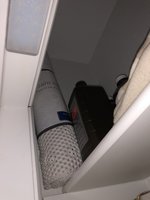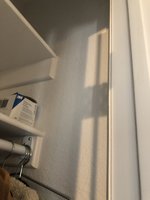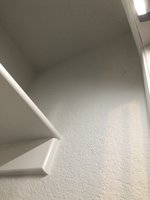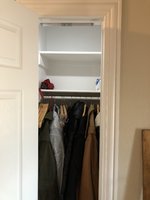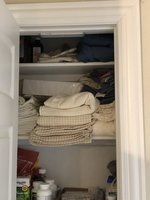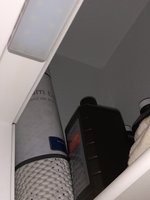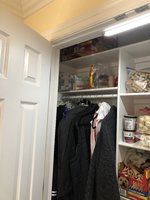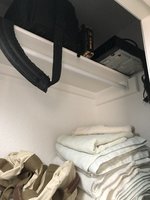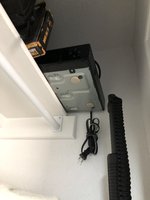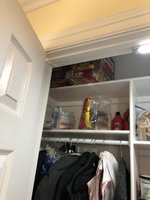Hello math fans!
I will get right to the point. (Well, sort of, I need to explain the dilemma.)
I’m 63, and have worked on this my whole life. I’m educated; and use geometry often. I’m a nurse. I’ve been a professional organizer in people’s homes as a side gig and often use geometry for furniture placement. Graph paper is my friend. Closets, however, are my downfall only because my OCD kicks in and I want the solution to ne as perfect as possible for containers on the shelves within the closets. It seems simple, but it’s NOT AT ALL SIMPLE.
If you take a look inside a closet, you generally see a shelf above the hanging rod inside the sliding or hinged door. You can measure the shelf for a container, l x w x h, but it usually doesn’t work (as in putting it on a shelf on a wall), because there is an angle at which you must place it in order to get it onto the shelf.
The various measurements that come into play are the wood trim, clothes on hangers (which would be kept in place, but those are pretty much standard width), but allow 20 inches width, and it also depends on where the bar is located in relation to the shelf for that measurement out from the shelf, yet lower than the shelf itself. The reason I mention this is that you don’t want to empty the closet to get something off the shelf. So that measurement depends on where the hanger edge lands, add that to the shelf depth. The measurement of the shelf itself (from the ceiling down) would be an additional amount of inches down from the shelf to the point of where the hanger extends out. I hope you are understanding that the hanger protrusion is a necessary consideration.
It’s also preferable to have the container protruding from the shelf itself by a few inches, to be angle to reach it easier since it’s generally high up, so I add that if it will “work”...
So... there’s an angle at which you must place the box in order to get it to the shelf itself. This angle would include the area between the hanger edge and the top of the closet, and the top of the closet door. Those measurements count. Also the shelf width counts of course! ?
The bottom line is, before I die, I need a formula! I’ve been dealing with this my whole life, just moved to my forever home, and want to buy containers for my closet that will be functional and space-saving because it is a small home with small closets. The containers should slide directly onto and off the shelf without having to turn them sideways. Just one row (not stacking them) of containers on a shelf.
In this formula, the width of the shelf can be used as on definitive container measurement, but can be any measurement of course. The length of the shelf is irrelevant regarding the width of the container, as long as it fits the doorway width. The height and length of the container (assuming its rectangular or square) is the variable to be solved, if I’m correct. One issue is the angle, at the top and bottom of the container when you lift it onto a high shelf, from the lower closet door opening, considering the length of the container. It’s an inverted right angle inside the closet, but needs to become a different angle for the box to angle in from outside the door, depending on the height of the box, and the height of the shelf above the top of the door edge opening. We may be looking at two different formulas to make this workable?
Is a formula for the optimal container size (maximum dimensions for storage, height and length with width as a variable)even possible? I think it is, but have not been able to come up with one. Your mission, if you choose to accept it, is to help me get my sanity back. Good luck and thanks so very much for all your work, helping those that need a helping hand. Thank you in advance!
Bottom line: what I need is a formula, based on measurements of the closet itself, and angles and door opening and all things considered for a single container that will work to slide onto any closet shelf.
Ladies and gentlemen: I give you my issue, to save mankind from wasted space and forever having to purchase more containers that never quite work the first time, and thank you from the bottom of my heart for tackling this question. The first mathematically correct answer is a true math genius. I have been tackling this my whole life! Thank You! Thank You! Thank You!
Peggy
I will get right to the point. (Well, sort of, I need to explain the dilemma.)
I’m 63, and have worked on this my whole life. I’m educated; and use geometry often. I’m a nurse. I’ve been a professional organizer in people’s homes as a side gig and often use geometry for furniture placement. Graph paper is my friend. Closets, however, are my downfall only because my OCD kicks in and I want the solution to ne as perfect as possible for containers on the shelves within the closets. It seems simple, but it’s NOT AT ALL SIMPLE.
If you take a look inside a closet, you generally see a shelf above the hanging rod inside the sliding or hinged door. You can measure the shelf for a container, l x w x h, but it usually doesn’t work (as in putting it on a shelf on a wall), because there is an angle at which you must place it in order to get it onto the shelf.
The various measurements that come into play are the wood trim, clothes on hangers (which would be kept in place, but those are pretty much standard width), but allow 20 inches width, and it also depends on where the bar is located in relation to the shelf for that measurement out from the shelf, yet lower than the shelf itself. The reason I mention this is that you don’t want to empty the closet to get something off the shelf. So that measurement depends on where the hanger edge lands, add that to the shelf depth. The measurement of the shelf itself (from the ceiling down) would be an additional amount of inches down from the shelf to the point of where the hanger extends out. I hope you are understanding that the hanger protrusion is a necessary consideration.
It’s also preferable to have the container protruding from the shelf itself by a few inches, to be angle to reach it easier since it’s generally high up, so I add that if it will “work”...
So... there’s an angle at which you must place the box in order to get it to the shelf itself. This angle would include the area between the hanger edge and the top of the closet, and the top of the closet door. Those measurements count. Also the shelf width counts of course! ?
The bottom line is, before I die, I need a formula! I’ve been dealing with this my whole life, just moved to my forever home, and want to buy containers for my closet that will be functional and space-saving because it is a small home with small closets. The containers should slide directly onto and off the shelf without having to turn them sideways. Just one row (not stacking them) of containers on a shelf.
In this formula, the width of the shelf can be used as on definitive container measurement, but can be any measurement of course. The length of the shelf is irrelevant regarding the width of the container, as long as it fits the doorway width. The height and length of the container (assuming its rectangular or square) is the variable to be solved, if I’m correct. One issue is the angle, at the top and bottom of the container when you lift it onto a high shelf, from the lower closet door opening, considering the length of the container. It’s an inverted right angle inside the closet, but needs to become a different angle for the box to angle in from outside the door, depending on the height of the box, and the height of the shelf above the top of the door edge opening. We may be looking at two different formulas to make this workable?
Is a formula for the optimal container size (maximum dimensions for storage, height and length with width as a variable)even possible? I think it is, but have not been able to come up with one. Your mission, if you choose to accept it, is to help me get my sanity back. Good luck and thanks so very much for all your work, helping those that need a helping hand. Thank you in advance!
Bottom line: what I need is a formula, based on measurements of the closet itself, and angles and door opening and all things considered for a single container that will work to slide onto any closet shelf.
Ladies and gentlemen: I give you my issue, to save mankind from wasted space and forever having to purchase more containers that never quite work the first time, and thank you from the bottom of my heart for tackling this question. The first mathematically correct answer is a true math genius. I have been tackling this my whole life! Thank You! Thank You! Thank You!
Peggy


